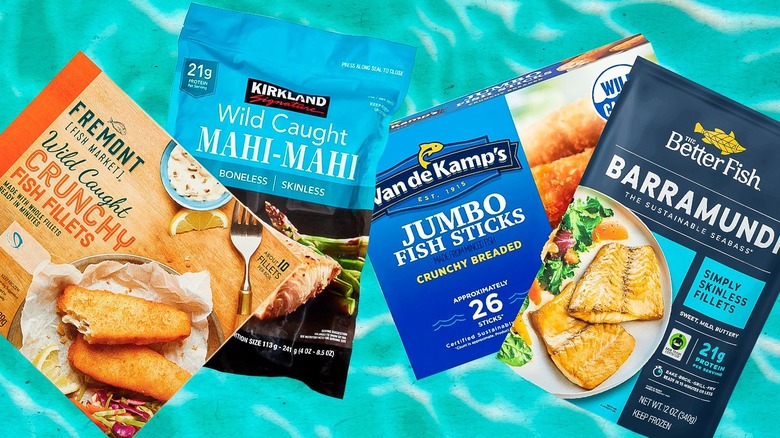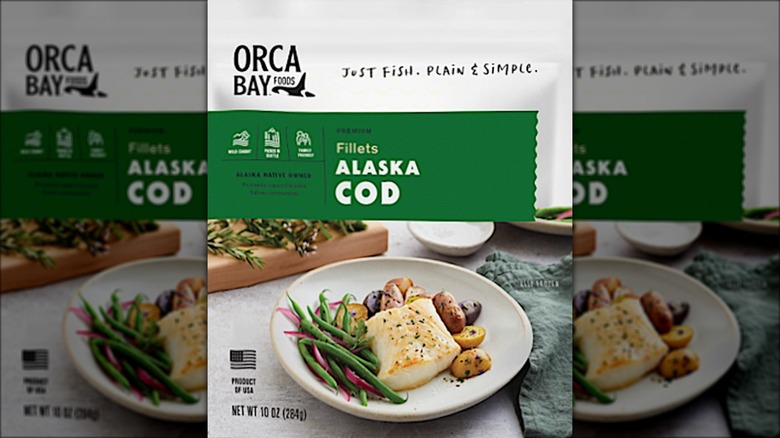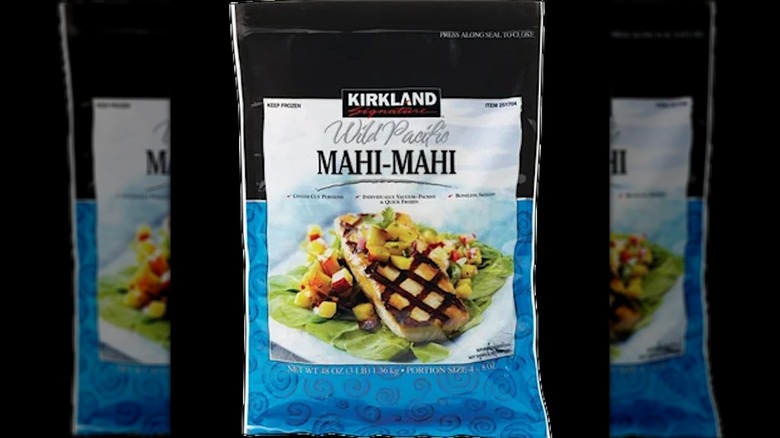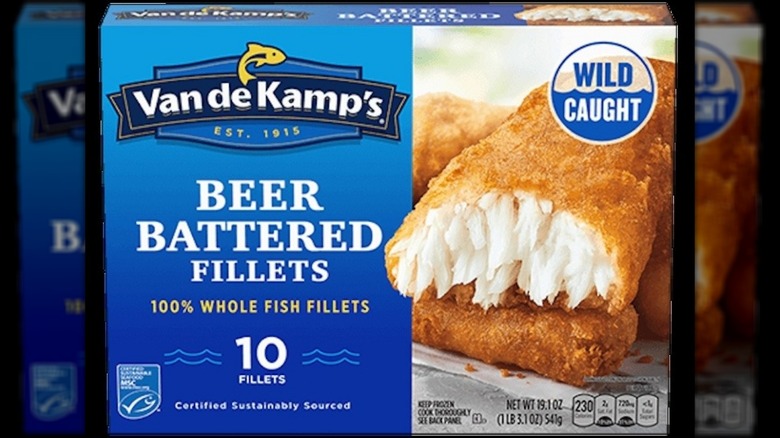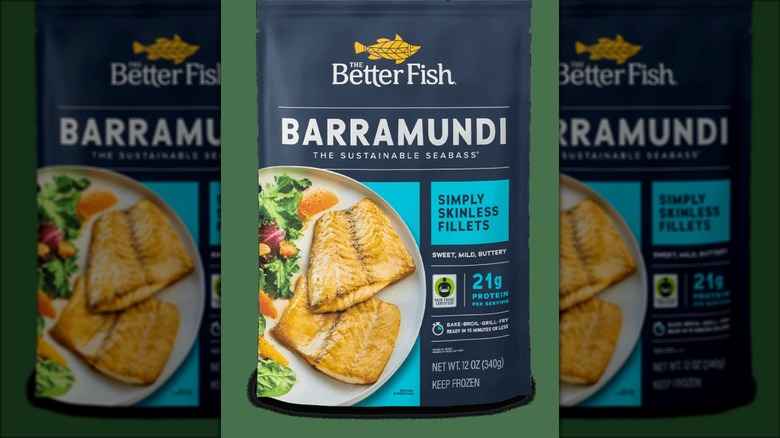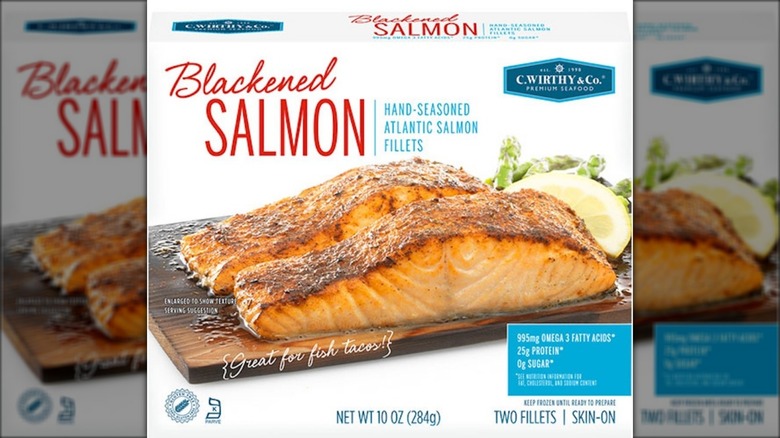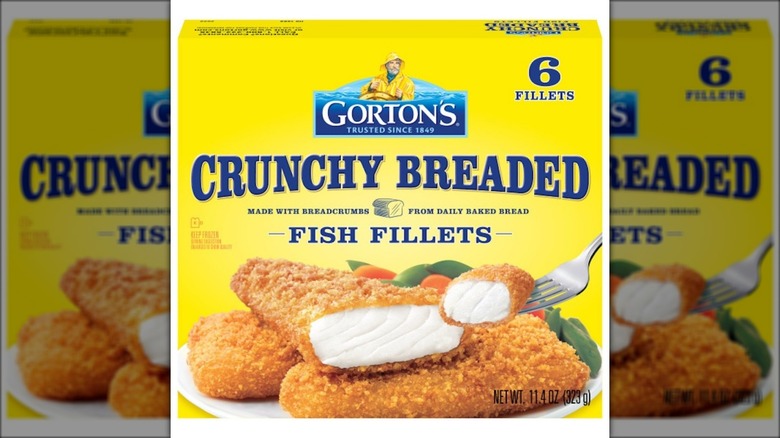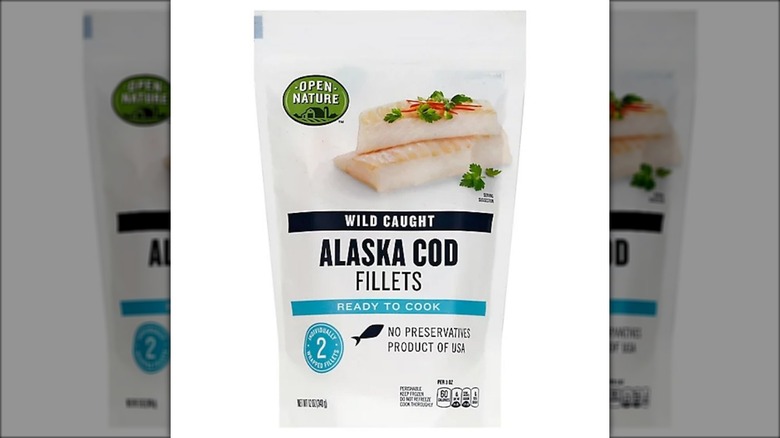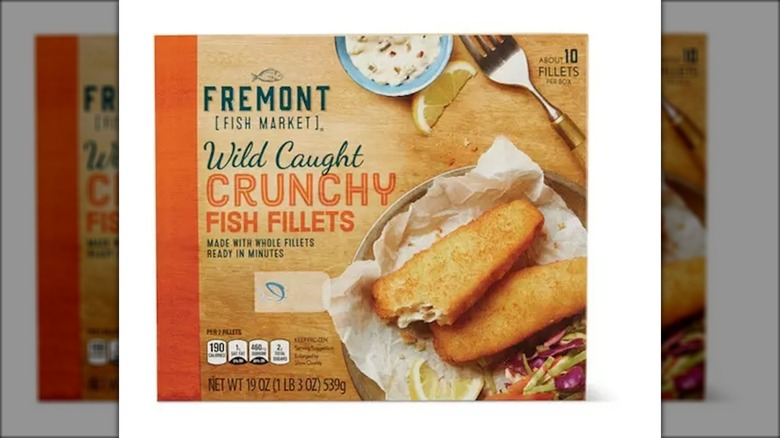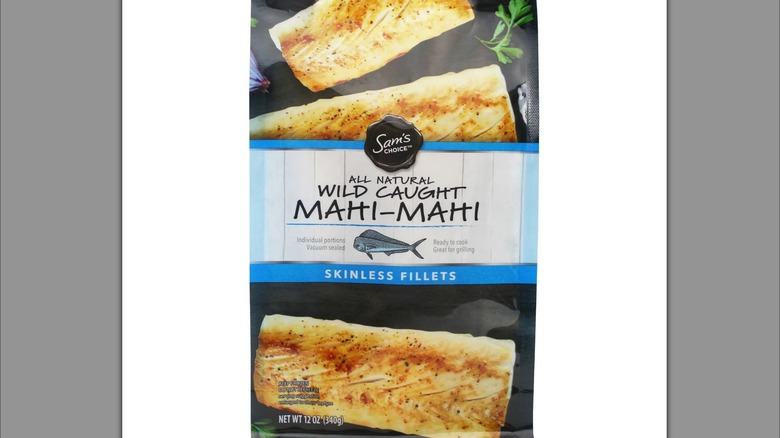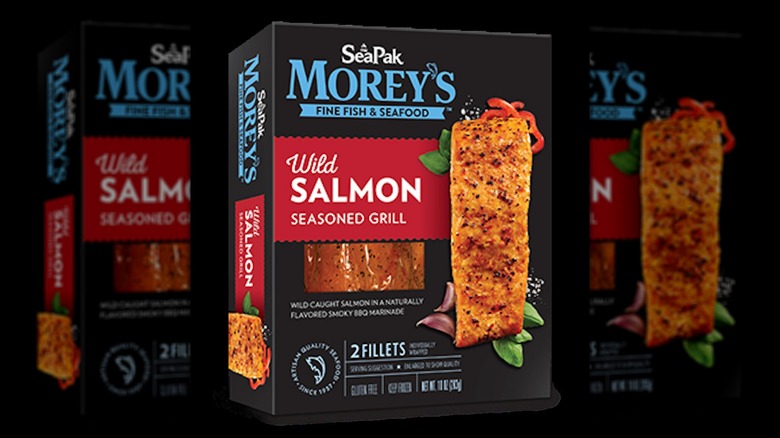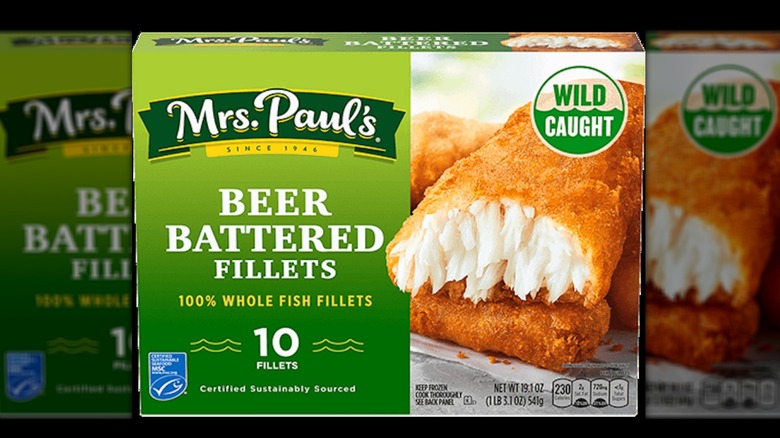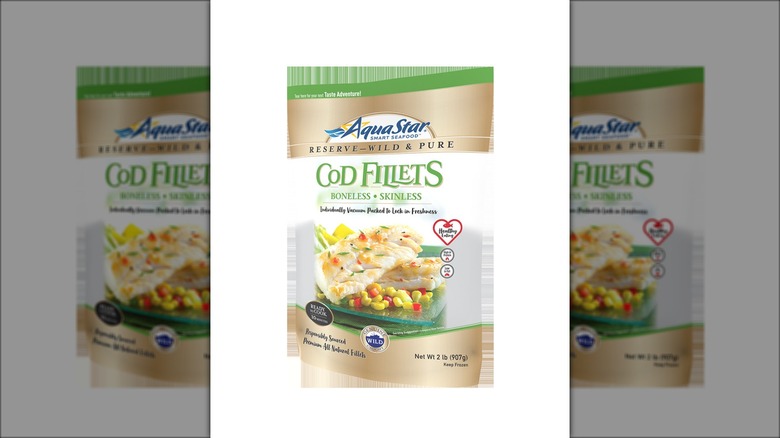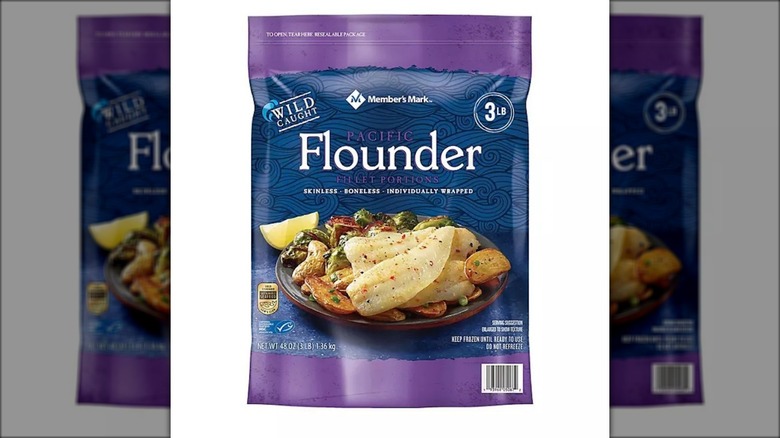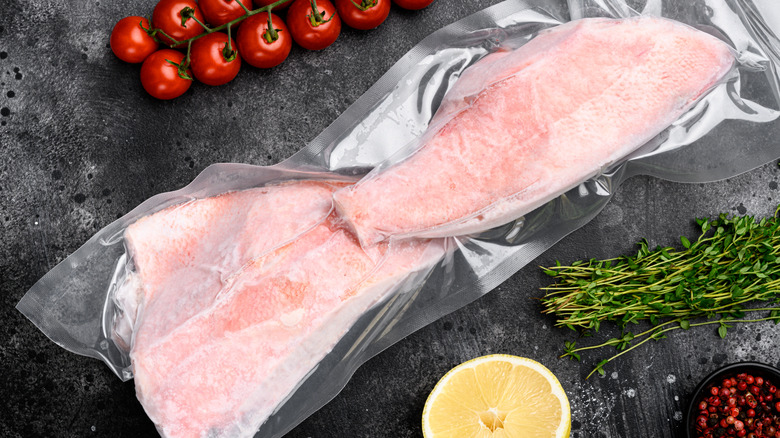The Highest And Lowest Quality Frozen Fish Fillets You Can Buy
Frozen fish fillets are a great food item to have on hand because they're quick and easy to prepare and make for a tasty meal. But are they actually healthy? And can they compare to fresh fish? Some would argue that frozen fish is actually better than fresh because the fish is preserved in a state that is closer to fresh than the fillets that sit on display at the supermarket. Plus, many frozen fish brands use high-quality ingredients in their products like wild-caught fish and natural herbs and spices.
A quick look at the ingredient list on a package of frozen fish fillets should tell you everything you need to know about whether the product is top-notch or slightly sketchy. However, we know that it's not always easy to decipher what the label on your frozen fish really means. To save you the trouble of trying to slog through ingredient lists at your local supermarket, we put in the hard work for you. These are the highest and lowest quality frozen fish fillets you can buy based on the integrity of the ingredients. We'll go into more detail about our methodology at the end of the article.
High Quality: Orca Bay Foods Alaska Cod Fillets
Founded in 1981, Orca Bay Foods is a Seattle-based seafood company that offers a wide range of products. The company claims to freeze its fish immediately after it's harvested and then portions and processes it in the company's own temperature-controlled facility. Much of the frozen fish Orca Bay Foods sells is sourced locally, including the Alaska Cod Fillets. The company is committed to sustainable fishing practices, so the cod comes from healthy stocks in Alaskan waters.
The truth about cod is it's a lean, flaky fish that is packed with protein, omega-3 fatty acids, and vitamin B12. Orca Bay Foods skins, trims, and cuts the fish into fillets that are sold in 10-ounce packages. There are no added sugars, salt, preservatives, artificial colors, or artificial flavors. In fact, the company doesn't add anything to the fish. What you get is straight-up cod fillets, so you can enjoy the mild, slightly sweet flavor on its own or season it to your preference. A single serving contains about 80 calories and 20 grams of protein, making this a great option for any clean eating plan.
High Quality: Kirkland Signature Wild Pacific Mahi-Mahi Fillets
If you have a Costco membership, you're probably well aware of the company's in-house Kirkland Signature brand and how great some of those products are. One such product is the Kirkland Wild Pacific Mahi-Mahi Fillets. The package contains center-cut, boneless, skinless mahi-mahi fillets that have been quick-frozen and individually vacuum-packed. The entire bag weighs 3 pounds, which is perfect for large households or those who simply want to stock up on frozen fish.
This is another frozen product where the fish is the only ingredient. For those who don't know what mahi-mahi is and what it tastes like, it's a warm-water whitefish with lean meat that is semi-mild with just a touch of sweetness. The packaging says a single serving (one fillet) weighs about 40 ounces and contains 21 grams of protein and 100 calories. A single serving also contains a decent amount of iron and potassium, with 6% and 10% of the daily recommended values, respectively. Overall, what you get is a high-quality product that's been minimally processed, contains no additives, and is low in calories.
Low Quality: Van de Kamp's Beer Battered Fillets
Van de Kamp's began back in 1915 as a potato chip stand, which is a pretty good indication that healthy food wasn't part of the original company ethos. It later went on to sell baked foods and then became a restaurant chain that sold battered, deep-fried fish. Although the restaurants are now defunct, Van De Kamp's still sells breaded frozen fish products. You can get fish fillets, fish sticks (regular or shark-shaped), and breaded fish patties for burgers, sandwiches, and tacos.
The brand's Beer Battered Fish Fillets consist of wild-caught pollack coated in a batter that includes wheat flour, corn flour, and beer. So far, not so bad. However, a scan through the ingredient list reveals some less than savory characters. First, the company adds sodium tripolyphosphate to the fish. This additive is often used to retain moisture. However, it can also make fish appear firmer, look better and weigh more from all that water retention. The ingredients also reveal chemical compounds like sodium acid pyrophosphate and monocalcium phosphate. While these additives aren't necessarily bad for you in small doses, they're not exactly ideal either.
High Quality: The Better Fish Simply Skinless Barramundi Fillets
The Better Fish brand was founded with the goal of providing healthy, sustainable seafood that is good for the body and the planet. There are a number of ways the company lives up to its name. First, it focuses on responsible aquaculture, raising ocean-farmed barramundi in low densities. The controlled environments ensure the fish contains no antibiotics, mercury, or hormones. The fish are hand-filleted and then flash-frozen, packaged, and transported by ship to cut back on carbon emissions.
Barramundi, also known as Asian sea bass, is a tropical white fish that has a sweet, buttery flavor. It's a pretty lean fish with moderate fat content. It's also packed with omega-3 fatty acids and protein. The Better Fish Simply Skinless Fillets contain no other ingredients beyond the fish, and they clock in at 21 grams of protein per 113-gram serving. One serving will also give you 50% of the recommended daily intake of vitamin D. If you're looking for an environmentally friendly product made with quality fish, this is a good bet.
Low Quality: C. Wirthy & Co. Blackened Salmon
If you're a fan of Louisiana cuisine, you may be drawn to the Blackened Salmon by C. Wirthy & Co. Each package contains two Atlantic salmon fillets coated in a blend of seasonings. The company states that its salmon products are flash-frozen and then vacuum-wrapped to preserve all the nutrients and flavors. At first glance, it looks like a decent frozen fish fillet product. But delve a bit deeper, and there are some red flags about the Blackened Salmon.
One of the facts about salmon that many people don't know is that all Atlantic salmon is farmed. That's because there are few wild Atlantic salmon left in the U.S., so fishing them is prohibited. Time Magazine reported that farmed salmon can contain harmful chemicals and that the farms themselves can be detrimental to the environment. Farmed salmon are often dyed to look like wild salmon, and that's the case with C. Wirthy & Co.'s Blackened Salmon. The ingredients also list additives like tri-calcium phosphate and silicon dioxide as anti-caking agents. Tasty? Maybe. Top-quality? Not so much.
High Quality: Gorton's Crunchy Breaded Fish Fillets
Breaded fish fillets may not be as healthy for you as non-breaded fillets, but that doesn't necessarily mean they're low-quality. If you're craving a bit of crunch and want something that's made of mostly good stuff, Gorton's Crunchy Breaded Fish Fillets are a good option. The company is a biggie on the frozen fish scene and much loved by many. In fact, a Mashed poll revealed that nearly 41% of respondents agreed that Gorton's was the best frozen fish brand.
Gorton's has been around since 1849, and it was the first company to introduce frozen, ready-to-cook fish sticks to the American market. In fact, the company claims it was the first to invent frozen convenience food in general. The company's motto is "If something's worth doing, it's worth doing right," and that seems to be the case with the Crunchy Breaded Fish Fillets. Each package contains two wild-caught Alaska pollock fillets coated in a panko breadcrumb crust. There are no preservatives or unnecessary additives — just things you might use at home like fish, corn flour, baking powder, and onion powder.
High Quality: Open Nature Wild Caught Alaska Cod Fillets
If you shop at Albertsons, you may be familiar with the company's Open Nature brand. Albertsons states that the collection includes "high-quality products and thoughtfully chosen ingredients at accessible prices." You can also find Open Nature products at other retailers like Safeway and Acme. The products include a range of frozen seafood options including the Wild Caught Alaska Cod Fillets. Each package contains two fish fillets that have been sustainably sourced and are free of preservatives.
The ingredient list for the Wild Caught Alaska Cod Fillets has just one food: Pacific cod. A single serving (one fillet) contains 120 calories and 400 milligrams of potassium, which is about 8% of the daily recommended intake. Each fillet also offers an impressive 32 grams of protein. There are no fats whatsoever, which is another selling point. The only thing to note is that each fillet also contains 640 milligrams of sodium, which is roughly 26% of the daily recommended value. Besides that, this is a pretty wholesome product.
Low Quality: Fremont Fish Market Wild Caught Crunchy Fish Fillets
Peruse the frozen foods section at an Aldi supermarket, and you'll probably come across the company's Fremont Fish Market products. Options include cod, haddock, and pollock fillets in breaded and non-breaded forms as well as salmon burgers, shrimp, and a ready-made seafood boil. If you're having a tough time choosing which type of fillets to throw in your cart, you may want to cross the Wild Caught Crunchy Fish Fillets off your list. While the pollock may be sustainably sourced and wild caught, it's the other ingredients that are slightly suspect.
The Fremont Fish Market Wild Caught Crunchy Fish Fillets is another product that contains sodium tripolyphosphate to retain moisture. This means that each serving size of 106 grams may actually contain less fish than you think thanks to the water weight. In addition, the breaded fish fillets contain synthetic and processed ingredients like monocalcium phosphate as a leavening agent and autolyzed yeast extract, which is a flavoring agent. If you're trying to avoid additives, you may want to leave these fish fillets in the store freezer.
High Quality: Sam's Choice Wild Caught Mahi-Mahi Fillets
Sam's Choice is Walmart's private-label brand. It was named after Walmart founder Sam Walton, and it includes a wide range of products from baked goods and condiments to beverages and frozen seafood. The good news for fish fillet lovers is that there are some pretty top-quality Sam's Choice options like the Wild Caught Mahi-Mahi Fillets.
Each bag of Wild Caught Mahi-Mahi Fillets contains three skinless mahi-mahi fillets that are individually portioned and vacuum-sealed. What you see is what you get — just mahi-mahi with no extra ingredients or preservatives. Each serving (one fillet) weighs about 4 ounces and contains 100 calories, 21 grams of protein, and only one gram of fat. A single fillet also contains only 100 milligrams of sodium. That's only 4% of the daily recommended value, which makes this a good choice for anyone watching their salt intake. And once these fillets are properly thawed, you can grill, bake, broil or heat them up in a skillet with your favorite seasonings. Or try this simple baked mahi mahi recipe.
High Quality: Morey's Wild Salmon Seasoned Grill
Morey's Fine Fish & Seafood has an interesting origin story. Back in the 1930s, Minnesota farmer Ed Morey encountered a fisherman with a broken down truck and a load of fish. Morey decided to trade a bunch of corn for the fish, and that sparked the creation of his seafood company. Today, Morey's offers a selection of seasoned, frozen fish products made with sustainably sourced wild and farmed fish. One of the highest-quality products the company offers is the Wild Salmon Seasoned Grill.
When it comes to farmed salmon versus wild salmon, many people agree that wild salmon is the better choice. Wild salmon eat natural foods, while farmed salmon often eat processed foods, some of which may contain antibiotics. In addition, wild salmon tends to have a more intense flavor. Morey's Wild Salmon Seasoned Grill features wild pink salmon that is seasoned with olive oil and natural ingredients like garlic, paprika, and red bell pepper. One fillet contains about 27 grams of protein and 8 grams of fat. The calorie count is slightly higher than other fish fillets on this list at 200 grams, but it may be worth it for the quality ingredients.
Low Quality: Mrs. Paul's Beer Battered Fish Fillets
Mrs. Paul's was established in 1946 as a frozen seafood company. The brand has changed hands a few times over the past 70-plus years, and it's now part of Conagra Brands, which also includes Van de Kamp's. Perhaps then it's not surprising that Mrs. Paul's products are strikingly similar to Van de Kamp's offerings. You can get beer-battered fillets, breaded patties, and breaded fish sticks. The company also offers shark-shaped fish sticks and crab cakes. And just like Van de Kamp's, Mrs. Paul's Beer Battered Fish Fillets contain some not-so-great ingredients.
Once again, we see sodium tripolyphosphate, which is used to retain water. Sodium acid pyrophosphate and monocalcium phosphate are also listed in the ingredients as well as dextrose (a sugar typically found in wheat or corn). The fish fillets are made of pollock, which is not usually farmed, so the fillets at least have that going for them. Truthfully though, there's nothing that differentiates these fillets from the Van de Kamp's Beer Battered Fish Fillets. They're essentially the same low-quality product under a different name.
High Quality: Aqua Star Wild Pacific Cod Fillets
Established in 1990, Aqua Star is relatively new to the frozen fish scene. The Seattle-based company is committed to social and environmental responsibility, so it sets high standards for its seafood suppliers. Many of its frozen fish products feature wild-caught fish from North American waters. If you're looking for a healthy, high-quality product to stock up on, consider adding the Wild Pacific Cod Fillets to your shopping list.
Each 2-pound package of Aqua Star Wild Pacific Cod Fillets contains skinless cod fillets — nothing more and nothing less. The fillets are individually vacuum-packed to seal in the flavors and prevent freezer burn. A 4-ounce serving is just 80 calories and contains no fat or sugars. You only get about 17 grams of protein, which is less than some of the other fillets on this list, but it's still not bad. The sodium levels aren't bad either, with a single serving containing 340 milligrams, which equates to about 15% of the daily recommended value. Overall, these fish fillets are all-natural, sustainably sourced, and a decent source of protein.
High Quality: Member's Mark Wild Caught Alaska Flounder Fillets
Member's Mark is Sam's Club's private brand. The philosophy behind the brand is to offer high-quality products at attractive prices. If you have a Sam's Club membership, you can choose from a huge array of products, including furniture, clothing, baked goods, fresh meats, and frozen seafood. If it's frozen fish fillets you're after, you could do a lot worse than the Wild Caught Alaska Flounder Fillets.
Flounder may not look too appetizing in its natural state. These flatfish are oval-shaped and brownish-gray on one side and white on the other. They have eyes only on one side of their flat bodies. However, the meat is flaky, mild, and a good source of protein and omega-3 fatty acids. The Member's Mark Wild Caught Alaska Flounder Fillets ring in at 80 calories per 4-ounce serving and contain 17 grams of protein and 0.5 grams of fat. The only thing that is not ideal about product is it contains sodium tripolyphosphate as a moisture retainer. However, other than that, you just get pure flounder and water.
Methodology
To determine which brands offer the highest and lowest quality fish fillets, we scoured through ingredient lists in search of the good, bad, and ugly. We took several factors into consideration, including whether the products contained natural ingredients or had additives like artificial colors and flavors. We also looked at whether the fish was sustainably sourced and wild caught. If the fish was farmed, we researched how much effort the companies put into responsible aquaculture. We also looked at nutritional values to see how healthy the fillets were or whether they were high in calories or sodium.
